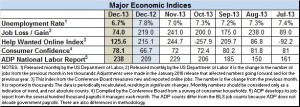 The government’s estimates of December’s job growth released this morning stunned analysts with the report of an anemic 74,000 new jobs.
The government’s estimates of December’s job growth released this morning stunned analysts with the report of an anemic 74,000 new jobs.
The report from the Bureau of Labor Statistics was expected to show about 200,000 new jobs last month. It contradicts other, positive signs of economic strength, including strong home sales, a rise in the manufacturing index over the last several months and growing consumer confidence. The National Employment Report from ADP and Moody’s Analytics, out Wednesday, estimated the private sector in December added 238,000 non-farm jobs.
The job growth number was the worst since May 2011.
The only significant strength came from retailing (up by 55,300 jobs) and temporary employment, which added 40,400 jobs. During all of 2013, the temp industry added 247,400 jobs, surpassing even healthcare, which grew by 207,600 jobs during the year. In December, according to the BLS, the sector actually shed 6,000 jobs.
So surprising was the report that Kathy Bostjancic, director of macroeconomic analysis with the business research group The Conference Board, issued a statement saying, “A gain of only 74,000 new jobs in December stands in contrast to the strengthening posted in other major economic data, suggesting the dip in hiring might prove temporary.”
Even the drop in the unemployment rate – from 7.0 percent to 6.7 percent — was more a sign of weakness than strength, as it was in large part due to workers dropping out of the labor force. The BLS said, “The civilian labor force participation rate declined by 0.2 percentage point to 62.8 percent in December, offsetting a change of the same magnitude in November.”
During 2013, the participation rate dropped .8 percentage points.
Numerically, there were almost half a million fewer unemployed persons in December, and 1.9 fewer for the year. According to the report, 10.4 million Americans are officially unemployed. An additional 7.8 million are working par-time because they can’t find full-time work, and 2.4 million more are out of work and looking, but didn’t meet the official definition of unemployed.
When these numbers are added to the official unemployed counts, the so-called U-6 unemployed and underutilized percentage is 13.1 on a seasonally adjusted basis.
Most industry sectors either shed jobs or had only modest increases in hiring. Construction lost 16,000 jobs in the government report. In the ADP report, it was one of the strongest industries, contributing 48,000 jobs. Manufacturing grew by 9,000 jobs; ADP said 19,000 new manufacturing jobs were created.
Though the two reports rarely are in perfect alignment — the methods of collecting and analyzing the numbers are significantly different — they are equally as rarely this far apart. The sharp differences in both the reports and with what labor economists were expecting prompted Moody’s chief analyst Mark Zandi, a lead analyst on the ADP report, to say on CNBC that he expects the government will significantly revise its December report when it issues its report on January’s job market Feb. 7th.
Each monthly jobs report is technically preliminary and is typically revised at least twice. Today’s report revised upward the November jobs count from an initial 203,000 new jobs to 241,000. No adjustment was made for October.